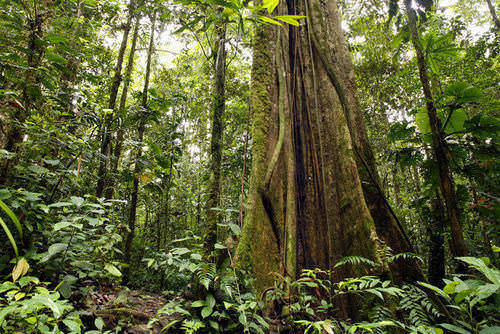2.5 变化率-interactive
章节大纲
-
Learning Objectives
::学习目标-
Understand rate of change as the change in output over the change in input.
::将变化率理解为相对于投入变化的产出变化。 -
Calculate and interpret the
average rate of change
from
a
graph and from an equation of a function over a specified interval.
::计算并解释图表和特定间隔函数方程式的平均变化率。
Introduction: Studying Deforestation
::导言:研究毁林问题Christie is an environmental scientist studying the effects of deforestation. The interactive below displays a graph of the world’s forest area in square kilometers from 1990 to 2016.
::克里斯蒂是一位环境科学家,研究砍伐森林的影响。 下面的互动展示了1990年至2016年世界森林面积的平方公里图。Christie wants to determine if the decrease in forest area is linear . What would a linear decrease look like? How would she know if it wasn’t linear?
::克里斯蒂想确定森林面积的减少是否是线性的。 线性的减少会是什么样子? 她怎么知道如果不是线性的呢?
Activity 1: Studying Deforestation Continued
::活动1:继续研究毁林问题The following formula can be used to calculate average velocity:
::以下公式可用于计算平均速度:
::平均速度=远距离时间=结束位置 - 开始定位时间 - 开始时间This formula can be generalized beyond functions representing position over time to find the average rate of change for any function. Rate of change is the ratio of change in output to change in input over a specified interval.
::该公式可以除代表长期位置的职能外,普遍适用,以找到任何职能的平均变化率。 变化率是产出变化与特定间隔内输入变化的比率。Suppose Christie wants to find the average rate of change in the rainforest area from 1990 to 2016. In the graph provided above, the axis represents the forest area (in square kilometers) and the axis represents the year. Thus, the forest area is displayed as a function of the year: is the year and is the forest area.
::假设Christie想要找到1990年至2016年雨林区的平均变化速度。 在上述图表中, Y 轴代表林区( 以平方公里计) , x 轴代表年份。 因此, 林区显示为当年的函数: x 是年份, f (x) 是林区 。To calculate the average rate of change, find the ratio of the change in forest area to the change in time . The change in area can be found by subtracting the area in 1990 from the area in 2016 :
::要计算平均变化率,请找到森林面积变化与时间变化的比率。 面积变化可以通过在1990年从2016年的面积中减去面积来发现:-
The forest area in 2016
was
39,958,246 km²
::2016年的森林面积为39 958 246平方公里 -
The forest area in 1990
was
41,282,695 km²
::1990年的森林面积为41,282,695平方公里。
The negative value represents a decrease in area. To find the change in years, subtract the years . Since the forest area in 2016 was subtracted from the forest area in 1990, subtract the years in the same order:
::负值代表面积的减少。 要查找年数的变化, 请减去年数。 由于2016年的森林面积在1990年从森林面积中减去, 减去年数的顺序相同 :The rate of change will be the ratio of the change in forest area to the change in time:
::变化率是森林面积变化与时间变化的比率:Answer: On average, the world’s forest area decreases by 50,940 square kilometers per year.
::答复:世界森林面积平均每年减少50 940平方公里。Answer the questions below to explore this further and determine if this is a linear function.
::回答下列问题,以进一步探讨这一问题,并确定是否属于线性功能。Discussion Question : What could cause the average rate of change to decrease in this context?
::讨论问题:在这方面,什么可以导致平均变化率下降?
Activity 2: Finding Average Rate of Change From a Graph
::活动2:从图表中寻找平均变化率T he general formula for average rate of change of any function is:
::任何职能的平均变动率的一般公式是:
::变化率=f(b)-f(a)b-aNotice that this formula is similar to the slope formula. T he calculation for the average rate of change assumes a linear change between inputs. The rate of change at a specific point on a graph can be measured using the slope of a tangent line. T he rates of change at every possible value from to would average to the linear change between the points.
::注意此公式与斜坡公式相似。 平均变化率的计算假设输入之间的线性变化。 图形上某个特定点的变动率可以用正切线的斜度来衡量。 从a到b的每一种可能值的变动率平均到两点之间的线性变化。Answer the questions below to practice finding the average rate of change from a graph.
::回答以下关于从图表中找出平均变化率的做法的问题。
Activity 3: Finding Average Rate of Change Given a Function
::活动3:根据职能确定平均变化率Activity 1 discussed how to find the average rate of change from a graph. The values in the function resulted from human activity. Since the average rate of change is only calculated using two points from the function, all the other points are not accounted for. It may be the case that one of the two points used does not follow the general trend of the data, resulting in a misinterpretation of the average rate of change.
::活动1讨论了如何从图表中找到平均变化率。函数中的值来自人类活动。由于平均变化率仅使用函数中的两个点计算,因此其他各点不计算在内。使用的两个点之一可能没有遵循数据的一般趋势,导致对平均变化率的错误解释。To account for this, mathematicians fit a function to all the data points and then use the fitted function to find the average rate change, rather than specific data values. This is a similar process as fitting a line of best fit to a scatter plot.
::为此,数学家将函数适合所有数据点,然后使用适合的函数查找平均率变化,而不是特定的数据值。这是一个类似过程,它与适合散射图的最佳直线相匹配。In the example below, a function is fit to a dataset and then used to find the average rate of change between two values.
::在下面的例子中,函数适合数据集,然后用来查找两个数值之间的平均变化率。Example
::示例示例示例示例A car accelerates from 0 to 60 miles per hour. The speed of the car is represented as a function of time on the graph below. T he function has been fit to model the relationship. Find the average rate of change from 9 seconds to 16 seconds.
::车速从每小时0英里加速到60英里。 车速代表下图的时间函数。 函数 f( x) = 15x 适合模拟此关系。 查找平均变化速率从9 秒到 16 秒。To find the average rate of change from a function equation, use the same formula that was used to find the average rate of change on a graph :
::为了找到函数方程式的平均变化率,使用用于在图表中查找平均变化率的相同公式:
::变化率=f(b)-f(a)b-aT o find the average rate of change between and substitute 9 and 16 for and respectively:
::找到 x=9 和 x=16 之间的平均变化率,替代 a 和 b 的 9 和 16 :
::变化率=f(16)-f(9)16-9Then evaluate and using the equation:
::然后使用方程式对f(9)和f(16)进行评价:
::f(9)=159=15(3)=45f(16)=1516=15(4)=60S ubstitute these output values into the formula.
::将这些输出值替换为公式。
::变化率=60-4516-9=1572.1Answer: The average rate of change between 9 and 16 seconds was about 2. 1 miles per hour. On average, the speed increased by 2. 1 miles per hour every second.
::回答:9至16秒的平均变化速度约为每小时2.1英里,平均速度每秒增加2.1英里。Answer the questions below to practice finding the average rate of change from an equation.
::回答以下对实践提出的问题,找出从等式中得出的平均变化率。
Wrap-Up: Review Questions
::总结:审查问题Summary
::摘要-
Rate of change
is the ratio of change in output to change in input over a specific interval.
::变化率是产出变化与特定间隔内投入变化的比率。 -
The
formula to find
average
rate of change between two values is
::在两个值之间找到平均变化率的公式是 f(b)-f(a)b-a
-
Understand rate of change as the change in output over the change in input.

